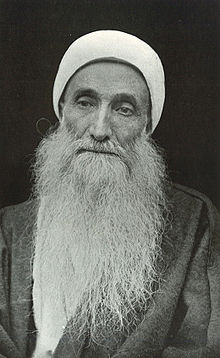Subh-i-Azal | |
|---|---|
 Subh-i-Azal at the age of 80, Famagusta, circa 1911[1] | |
| Born | Mirza Yahya Nuri 1831 Tehran, Iran |
| Died | April 29, 1912 (aged 80) Famagusta, present-day Cyprus |
| Known for | Leader of Azali Bábism |
| Successor | Disputed |
Subh-i-Azal[a] (1831–1912, born Mirza Yahya[b]) was an Iranian religious leader of Bábism who succeeded its founder the Báb as the central authority of the religion after the latter's execution in 1850.[2] He is known for his later conflict with his half-brother Baháʼu'lláh over leadership of the Bábí community, after which his followers became known as Azalis.
In 1850, when he was just 19 years old, he was appointed by the Báb to lead the Bábí community. When a pogrom began against the Bábís in 1852, Subh-i-Azal fled for Baghdad and spent 10 years there before joining the group of Bábí exiles that were called to Istanbul. During the time in Baghdad tensions grew with Baháʼu'lláh, as Bábí pilgrims began to turn to him for leadership. The Ottoman government further exiled the group to Edirne, where Baháʼu'lláh's announcement of divine revelation turned the tension into an open conflict.
In 1868 the Ottoman government further exiled Subh-i-Azal and his followers to Cyprus, and Baháʼu'lláh and his followers to Acre in Palestine. When Cyprus was leased to Britain in 1878, he lived out the rest of his life in obscurity on a British pension.[3]
After Azal's death in 1912, the Azali form of Bábísm entered a stagnation and has not recovered as there is no acknowledged leader or central organization.[2] Most Bábís either accepted the claim of Baháʼu'lláh or the community gradually diminished as children and grandchildren turned back to Islam.[4][5] By 1904, Azal's followers had dwindled to a small minority, and Baháʼu'lláh was almost universally recognized as the spiritual successor of the Báb.[6] A source in 2001 estimated no more than a few thousand, almost entirely in Iran.[7] Another source in 2009 noted a very small number of followers remained in Uzbekistan.[8]
- ^ Published in Harry Charles Lukach, The Fringe of the East, London, MacMillan, 1913, p.264.
- ^ a b MacEoin 1987.
- ^ Mirza Yahya. In Britannica 2014.
- ^ Manuchehri 2000.
- ^ Azali. In Britannica 2011.
- ^ Carus 1904, p. 361.
- ^ Barrett 2001, p. 246.
- ^ Campo 2009b.
Cite error: There are <ref group=lower-alpha> tags or {{efn}} templates on this page, but the references will not show without a {{reflist|group=lower-alpha}} template or {{notelist}} template (see the help page).